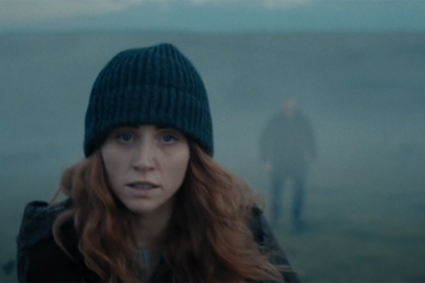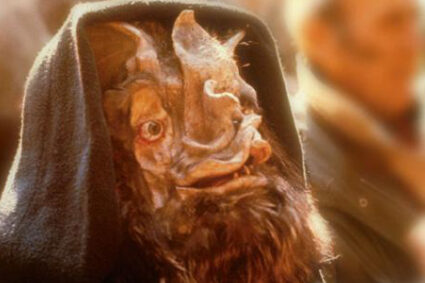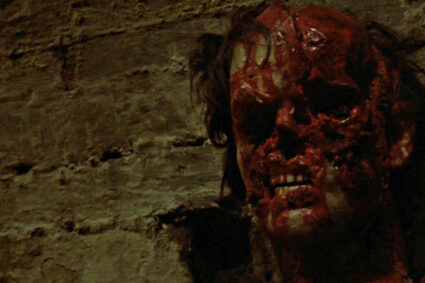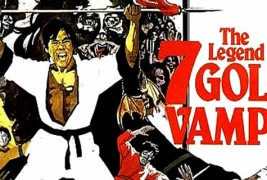
Ravenous Monster is proud to present you with the first gruesome diagnosis from the good Dr. Abner Mality of WormwoodChronicles.com….
Readers of a certain age (often referred to as “over the hill”) will definitely recall the famous ad campaign for Reese’s Peanut Butter Cups in the 1970’s. It dwelled upon how an unlikely combination of ingredients, peanut butter and chocolate, could produce a tasty treat. “Hey, you got your peanut butter in my chocolate!”
“Yeah? You got your chocolate in my peanut butter!” The truth of the ad’s point holds up today – not just for candy, but for music, art…and horror movies!
I’ve always had a hankering for odd combinations of genres in film. Sci-fi meets Western. Juvenile delinquent film meets murder mystery. And in the case of one unusual 70’s film, kung fu colliding head on with vampires! That weird peanut butter cup of a movie was 1974’s “The Legend of the Seven Golden Vampires” and that’s the flick that the Good Doctor is putting under the microscope for you followers of Ravenous Monster!
By the early 70’s, the powerhouse horror factory known as Britain’s Hammer Films was running out of steam. With the explosion of no-holds-barred gore and exploitation heralded by “Night of the Living Dead” and “Texas Chainsaw Massacre”, the taste for Hammer’s gothic period pieces was starting to wane. Aware of this, the studio rapidly began to inject more blood and nudity into their films. This resulted in some fascinating and titillating (literally!) products like “Dr. Jekyll and Sister Hyde”, “The Vampire Lovers” and “Twins of Evil”. Hammer also tried to go a more contemporary route by “updating” their Dracula films to the 20th century, a move many now consider a mistake as the likes of “Dracula AD 1972” and “The Satanic Rites of Dracula” seem more dated than the timeless 19th century period pieces Hammer cut its fangs on.
These tactics proved only marginally successful, so Hammer began thinking outside the box. If period horror was starting to decline in the early 70’s, other forms of exploitation were starting to take off. One such genre was the “blaxploitation” movie. The other breakout genre hailed from the Far East and involved martial arts. Driven by the sudden popularity of a guy named Bruce and movies such as “Enter The Dragon” and “Five Fingers of Death”, kung fu films, always popular in the East, began to explode in the West. The early 70’s were kung fu and karate crazy and one could find all sorts of authentic “chop socky” flicks playing continuously on New York’s 42nd Street and other havens of cult film.
The studio synonymous with real Chinese kung fu was Shaw Brothers. This Asian powerhouse ruled the Hong Kong film industry with an iron fist and produced such classic martial arts films as “The 36th Chamber of Shaolin”, “Executioners of Death” and “Five Deadly Venoms”. With their outrageous and often bloody stunts, wild zooming camera shots and melodramatic dialogue, these movies offered nothing but action and entertainment, in an exotic vein unfamiliar to most Western film fans.
Hammer decided to take a chance and reach out to Shaw Brothers. Shaw was looking for new ways to reach the Western market and considered the alliance worth a shot. They would get access to some Western stars and technical people while perhaps Hammer could get a shot in the arm. Peanut butter and chocolate, chocolate and peanut butter….
The collaboration was destined to be short-lived, as financial problems would put Hammer on the ropes in just a couple of years. Only two moves resulted from this odd alliance: the action thriller “Shatter” and the subject of our little treatise, “The Legend of the 7 Golden Vampires”.
“Legend…” was a troubled production from the get-go. The film was actually directed by both Roy Ward Baker, one of Hammer’s most respected professionals, and Chang Cheh, a legend of Hong Kong action films. On all remaining prints of the movie, only Baker’s name remains, though it is certain that Cheh directed most of the movie’s plentiful action scenes. Filmed entirely in Hong Kong, Baker was said to be uncomfortable with the Shaw Brothers’ method of doing things. Some of this awkwardness is noticeable in the final product, yet at the same time, the odd juxtaposition of styles has made “Legend of the 7 Golden Vampires” a true cult film.
As far as star power went, the movie boasted the incomparable Peter Cushing as Dr. Van Helsing. Cushing is one of the most professional actors who ever lived and his version of Van Helsing is in this Doctor’s opinion by far the best. Cushing was recovering from the devastating death of his beloved wife at the time but as always, he delivers a great performance as Van Helsing. On the Asian side of things, the main star was David Chiang. Almost forgotten in the West now, Chiang in the 70’s was second only to Bruce Lee as Asia’s biggest kung fu star. His acting in “Legend…” is hardly Oscar worthy, yet Chiang brings an honest earnestness to the role that overcomes his difficulty with English. For sex appeal, the film had the services of the ravishing former Miss Norway and Penthouse Pet, Julie Ege.
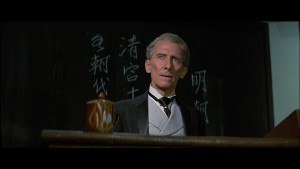
The major disappointment for many was the fact that Christopher Lee would not be playing his iconic part of Dracula in the film. Lee had a love-hate relationship with Dracula throughout the years and was in the middle of a “hate” phase when filming for “Legend…” commenced. Despite pleading from Hammer, Lee passed on the part, which went to the less well-known John Forbes Robertson. Robertson made for a passably sinister Dracula, but one can only imagine how the presence of Lee would have boosted the film.
After filming wrapped, trouble persisted. American distributors pretty much raped and emasculated the film, trimming almost 20 minutes of critical footage. It was released in its initial run as “The Seven Brothers Meet Dracula”, where the kung fu was emphasized far more than the Hammer horror aspects. These cuts made an already strange exploitation film virtually incomprehensible and took out a lot of atmosphere. More confusion resulted as the film acquired another name, “Dracula and the 7 Golden Vampires”, in its travels.
The movie was the source of much comment and did reasonable business on the exploitation circuit, particularly “The Deuce” of 42nd Street in New York, but it was not the break-out hit Hammer envisioned. The next Hammer/Shaw Brothers collaboration, “Shatter”, was an all-out failure and marked the final end of Peter Cushing’s long association with the studio. But, as often happens in cult film circles, the movie began to acquire a reputation in underground circles and it is now regarded as one of Hammer’s most unique and action-packed films.
Let’s now take a closer look at the story of “The 7 Golden Vampires” Be warned, spoilers follow!
Our film begins in Transylvania…not an uncommon location for a vampire flick. But a most uncommon figure is making his way through the Transylvanian countryside. A sinister looking Chinese monk is staggering through the forests, frightening a shepherd, and making his way towards a destination most sane people would avoid: Castle Dracula. The monk’s name is Kha and the story of his long voyage from remote China to Transylvania would make an interesting tale in itself
Finally, Kha enters the crypt of the vampire lord, who awakens and demands, “Who dares disturb the sanctity of Dracula?” John Forbes Robertson is not Christopher Lee but he has a commanding sneer of authority. It seems Kha is the evil priest of a vampire cult, serving the legendary Seven Golden Vampires of Ping Kuei. However, the oppressed peasants of Ping Kuei have risen against the vampire tyranny and one of the seven has been destroyed. Kha has been dispatched to Europe so that Dracula, most powerful of all vampires, will assume the position of the Vampires’ leader.

Dracula seems to dismiss the suggestion at first, but then decides he will accept Kha’s proposition. It’s time for a change of scenery and a vacation in China might get the Count away from pesky Dr. Van Helsing. If only he knew! But Dracula will not go as himself. He absorbs Kha’s lifeforce and assumes the image of the evil priest.
The movie shifts to a lecture hall at a Hong Kong university, where the esteemed Dr. Van Helsing is addressing a scholarly crowd on both Eastern and Western vampire legends. Van Helsing relates the story of a cursed village known as Ping Kuei, which has been under the thrall of Seven Golden Vampires, formerly bandit warlords, for centuries. The location of Ping Kuei is unknown but Van Helsing is convinced the village exists.
His audience is not impressed. In fact, Van Helsing’s theories are ridiculed and the Doctor is accused of thinking his Chinese hosts are superstitious fools. The scene makes one wonder why Van Helsing was even invited to China. But one man in the crowd takes heed of what he says and thereby hangs our tale.
The young man is Hsi Ching and he pays a late night visit to Van Helsing. Hsi Ching has no choice but to believe the doctor’s story about Ping Kuei because he himself comes from the cursed village. He confirms that the Golden Vampires have indeed had a reign of terror there, but recently things seem to have become worse. Ching’s grandfather had actually managed to kill one of the fiends but at the cost of his own life. Now some new deviltry has risen in Ping Kuei, making the vampires and their undead servants bolder.
This is the first part of the movie in which the Shaw Brothers influence is really shown. We get a flashback of Ching’s grandfather battling the vampires and this scene is 100% Hong Kong exploitation. The Chinese vampires are quite different from their European counterparts – crusty faced ghouls wearing elaborate robes and golden masks in the shape of bats. These monsters look really decrepit and unwholesome and they are definitely up to no good. In one of the film’s most memorable scenes, a circle of topless Chinese girls are bound and screaming on some sort of circular contraption, their blood running down troughs into a boiling cauldron. This is right out of the most nightmarish Chinese folk-tales!

Ching’s grandfather fails to save his daughter from the vampires but before he is hunted down and destroyed, he manages to kill one of the golden ghouls. This is the act that gives the villagers some hope, but now the vampires are on the offensive again and Ching fears his whole village will be destroyed.
Van Helsing agrees to help. He is not alone in China…his dashing young son Leyland has accompanied him (mostly to provide eye candy for possible female viewers, me thinks). The journey to remote Ping Kuei will be costly and arduous. Van Helsing visits the British Consul to see if help might be available. The British Consul points out the presence of Mrs. Vanessa Buren, a recently widowed wife of a fabulously wealthy husband. Played by gorgeous Julie Ege, I can DEFINITELY confirm she was added to provide eye candy for male viewers, no ifs, ands or buts about it. Julie was a middling actress but an incredibly beautiful woman.
As one might guess, Leyland and Vanessa have caught each other’s eye. Unfortunately for them, she has also caught the eye of local tong warlord Leung Han, who makes a thinly veiled play for the heiress. Leyland sticks up for Vanessa, but the Consul warns them that they have made a deadly enemy in Leung Han. Just how deadly is revealed when Leyland escorts Vanessa to her hotel and they are attacked by masked tong members.
Things look pretty dicey before some new friends come to the pair’s aid. Wielding a variety of weapons and fighting with great skill, the newcomers are the brothers (and sister) of Hsi Ching, who were dispatched with him to find help for their village. The Chings easily defeat Han’s goons. They had been watching Leyland all along to protect him. Each one of them is master of a particular weapon – one is an expert bowman, another wields axes, two are swordsmen, one uses spears. Pretty little Mei Kwei can handle herself just as well as the men and adds some exotic beauty to the flick.
The two parties of Van Helsings hook up and the decision is made for them to journey to Ping Kuei to liberate it from the Golden Vampires. Vanessa has made the decision to fund the expedition only if she can accompany it. She’s looking for some adventure in her life after being a pampered rich lady.
The expedition sets off to Ping Kuei and soon finds itself in barren, forbidding country. I like the fact that the closer they get to the realm of the vampires, the more dead and lifeless the landscape becomes. It gives things a nice sense of foreboding. The group is forced to battle another band of assassins sent out by Leung Han, leading to a spectacular kung fu battle where the Chings get to show their lethal skills.
I won’t reveal much more of what happens when Van Helsing & Co. finally reach the Village of the Damned. Attacks and counter-attacks are constant and the body count amongst our heroes is pretty high. There is a tradition in Shaw Brothers kung fu movies of “tragic heroes” who win the day at the cost of their own life. Well, the tradition lives on in “Legend…” but you’ll have to watch the film to see just who walks away and who doesn’t.
There are several things to note. The night time scenes here are extremely atmospheric and quite different from the Hammer norm. Perhaps the strongest scenes of the film involve the 7 Golden Vampires summoning their zombie slaves to serve them. These scenes of the skull-faced ghouls clawing their way out of their graves reminds me very much of “Tombs of the Blind Dead” and the horrific Templars rising from their tombs. But once roused, these creatures are seen to move with hopping, mincing steps, adding some unintentional humor. In fact, the “hopping” ghoul is a well known tradition of Chinese folklore.
I also got a kick out of how the 7 Golden Vampires are repelled by the sight of the Buddha instead of the crucifix. That makes perfect sense, actually.
It also warms my heart to see kung fu in the traditional old school style here. That means none of the CGI trickery or people flying on wires that has pretty much ruined modern films. If you’re unfamiliar with authentic Shaw Brothers kung fu, it’s a lot more physical and visceral, even with the exaggerated sound effects that make every blow sound like it snaps bones. These scenes were certainly directed by Chang Cheh.
The 7 Golden Vampires are a scary looking bunch but they do not speak. I am kind of split on whether this is a good thing or not. It’s for sure that European vampires like to talk. But these dusty, crusty looking creatures look as if speech might be difficult.
I was disappointed in the final confrontation between Van Helsing and Dracula/Kha. This is a common complaint amongst those who’ve seen the movie and I can’t dispute its lameness. Almost any previous Hammer film had a scarier, more violent battle between good and evil. Cushing has little to do beyond look concerned, but he’s such a natural actor that even limited action communicates a lot about Van Helsing’s character. He dominates the film as I expected he would.
I would have liked to have seen more of the villagers of Ping Kuei and how they coped with constant domination by the vampires and their servants. A little more depth and background would have helped to make the movie truly memorable, but that’s maybe too much to expect from an exploitation film.
What’s the final assessment of “Legend of the Seven Golden Vampires”? Well, for sure, you should seek out Anchor Bay’s original uncut version. Any other version will be the cut version that appeared as “The Seven Brothers Meet Dracula”, which is confusing and lacking the best footage.
I enjoy the movie for its combination of differing flavors…yup; it’s a peanut butter cup of a film for sure. Hammer purists are often disappointed with the movie and if you have no taste for kung fu or Eastern settings, I’d skip the movie entirely. But I think most exploitation fans are a little bit braver than that and the result is a movie that may not be the greatest vampire or chop socky flick you’ve ever seen, but you darn sure won’t forget it!


